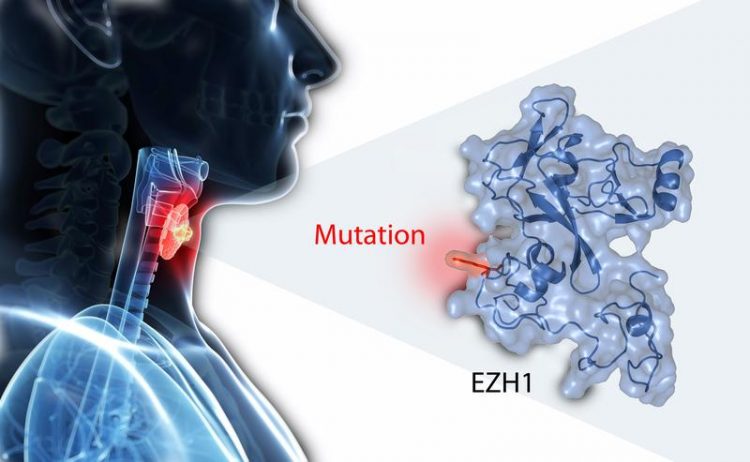Thyroid tumour: it takes two to tango

A significant number of autumnous adenomas carry a mutation in a gene that is involved in controlling cell proliferation and differentiation. EZH1 is its scientific name. Graphic: Davice Calebiro / Kerstin Bathon
Thyroid hormones are involved in controlling many functions of the human body: They influence sugar, lipid and protein metabolism, regulate body temperature, heart rate, circulation and many more functions. In children, they also control the development of the brain and nerves as well as bone growth.
No wonder that hyperthyroidism has several detrimental effects in the affected patients. Typical symptoms include persistent restlessness, irritability, insomnia, inexplicable weight loss, excessive sweating and an increased pulse. Untreated hyperthyroidism has severe consequences, including, most importantly, a higher mortality for cardiovascular disease.
Search for the responsible mutations
In many cases, such a hyperfunction is triggered by thyroid tumours, most of which are benign. Among them, the so-called autonomous adenoma accounts for the majority. Its genesis is in general well understood: “We know that special mutations in certain genes are responsible for around 70 percent of all autonomous adenomas,” says Dr. Davide Calebiro from the Institute of Pharmacology and Toxicology and the Bio-Imaging Center of the University of Würzburg.
However, it has been unknown until recently whether these mutations alone are sufficient to prompt thyroid cells to proliferate and produce excessive hormones, or whether additional factors have to be present. Also, it was unclear which factors are involved in the genesis of the remaining 30 percent of autonomous adenomas.
Publication in the Journal of Clinical Investigation
In the search for other causes of the disease, an international team of researchers, led by Davide Calebiro, Luca Persani from the University of Milan and Ralf Paschke from the University of Calgary, have now scored a success. Their results have been published in the current issue of Journal of Clinical Investigation (JCI) – Davide Calebiro is the first author of the study. Researchers from the group of Professor Martin Fassnacht from the Würzburg University Hospital also participated in the study. The Interdisciplinary Center for Clinical Research (IZKF) of the University of Würzburg supported the work.
“For our study, we examined 19 autonomous adenomas using whole exome sequencing,” Calebiro describes their approach. This technique does not investigate the entire genome of the cells; rather the focus is on the so-called exons of the genes – which are the pieces that are actually translated into proteins. Usually, the exons (“exome”) account for 1-2% of the total DNA. “We were able to show that a significant number of these adenomas carry a mutation in a gene that is involved in controlling cell proliferation and differentiation”, Calebiro further explained.
Gene mutation causes increased cell proliferation
EZH1 – or Enhancer of Zeste Homolog 1 – is the scientific name of this gene. EZH1 mutations work synergistically with the other known mutations, leading to the formation of autonomous adenomas. Moreover, functional studies show that EZH1 mutations modify signal pathways that cause thyroid cells to proliferate.
“We were able to show that a hot-spot mutation in the EZH1 gene is the second most common genetic defect in autonomous adenomas,” Davide Calebiro puts the result of their recently published work in a nutshell. In his opinion, the frequent association of EZH1 mutations with those in previously known genes points to a “two-hit model”. Accordingly, the first mutation increases the disposition for the formation of tumours, whereas the second triggers the disease process.
Recurrent EZH1 mutations are a second hit in autonomous thyroid adenomas. Davide Calebiro, Elisa S. Grassi, Markus Eszlinger, Cristina L. Ronchi, Amod Godbole, Kerstin Bathon, Fabiana Guizzardi, Tiziana de Filippis, Knut Krohn, Holger Jaeschke, Thomas Schwarzmayr, Rifat Bircan, Hulya Iliksu Gozu, Seda Sancak, Marek Niedziela, Tim M. Strom, Martin Fassnacht, Luca Persani, Ralf Paschke. Journal of Clinical Investigation, online published 08.08.16. doi:10.1172/JCI84894
Contact
PD Dr. Davide Calebiro, Phone: +49 931 31-80067, E-mail: davide.calebiro@toxi.uni-wuerzburg.de
Media Contact
All latest news from the category: Life Sciences and Chemistry
Articles and reports from the Life Sciences and chemistry area deal with applied and basic research into modern biology, chemistry and human medicine.
Valuable information can be found on a range of life sciences fields including bacteriology, biochemistry, bionics, bioinformatics, biophysics, biotechnology, genetics, geobotany, human biology, marine biology, microbiology, molecular biology, cellular biology, zoology, bioinorganic chemistry, microchemistry and environmental chemistry.
Newest articles

Silicon Carbide Innovation Alliance to drive industrial-scale semiconductor work
Known for its ability to withstand extreme environments and high voltages, silicon carbide (SiC) is a semiconducting material made up of silicon and carbon atoms arranged into crystals that is…

New SPECT/CT technique shows impressive biomarker identification
…offers increased access for prostate cancer patients. A novel SPECT/CT acquisition method can accurately detect radiopharmaceutical biodistribution in a convenient manner for prostate cancer patients, opening the door for more…

How 3D printers can give robots a soft touch
Soft skin coverings and touch sensors have emerged as a promising feature for robots that are both safer and more intuitive for human interaction, but they are expensive and difficult…





















